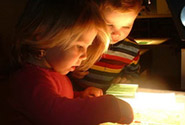Jan
14
Videatives Views Issue #220 How Toddlers Play with a Life Size Box
 Four children, ages one to one-and-a-half years old, explore a large box that was brought into the community space as part of a school wide investigation.
Four children, ages one to one-and-a-half years old, explore a large box that was brought into the community space as part of a school wide investigation.
Questions to consider
Why do the children tag the back of the box? Is this action functional or simply a conspicuous move that could be seen and imitated? Is it to confirm that they have entered into the box as far as they can go?
What is the purpose of slapping the outside rear of the box? Are they trying to move the box but cannot when there are children inside? Are they making a gestural comment that this is an outside wall compared to an inside wall?
Why do the children run in and out of the box instead of just walking? What is the source of their glee? Perhaps children feel an instinctive sense of joy when all cozy in a confined but safe place. Would they have as much fun with this box if both the front and back were open? Would running through a tunnel be as much fun as running into a closed box?
Does the darkness of the inside of the box attract the children? Could the in and out of the box create the same sort of joy that comes from a game of peek-a-boo, with the disappearance and reappearance of the person?
Are their gleeful screams correlated more with exiting or entering the box? Do they scream as a way to test the echo of the large room?
Around 02:00 the children start to push the box. In the first two minutes, the box moved infrequently, only when no children were inside. Why do the children want to move the box? Do they move it simply because they can? Might pushing somehow augment such a big box? Or, perhaps the box amplifies the effect of their pushing movement?
Look at How Spaces Support Social Play in the Videatives VSS. The children engage in the same running back and forth as they do with the box. In How Spaces Support Social Play the two endpoints are a cushioned corner and a wall of mirrors. The children tag the wall of mirrors on one end of their run. They express similar glee most likely because they realize they are running with each other and it is fun to play together. So in the box video, their glee might have less to do with the inside and outside structure of the box and more to do with how it affords repeated back and forth running, something a tunnel box would not do, or not do as well. It could be the children's recognition that they are "doing this again and doing it together" that gives them joy.
The joy may not be "learned" in the traditional sense of a pattern of behavior somehow guided in degrees by small reinforcements (e.g., positive guidance). Indeed, the joy seems to emerge from the very act of repetitive movement together, like the many routines that parents learn to repeat because of the joyful reaction of their children, such as peek a boo. It is the parents who are reinforced by the child's smile as opposed to the child's behavior being shaped by the parent.
Do the children realize that the box cannot be moved if someone is inside? Look at segment 02:00 to 03:00.
Do the children know the location of the open end when they are outside the back of the box? Watch Finley run to the front around 03:52. He can see the closed side as he runs but his run seems continuous so it appears he knows in advance where the open end is located.
Can you think of any reason why Finley goes to the same corner and sits down on most of his entries into the box?
When and why does Wyatt clap his hands? Does this clapping indicate he has just experienced something that gives him joy, something that frustrates him, or something that makes him anxious?
Do the children feel incomplete if they cannot touch, or stand, or sit next to the back inside wall of the box?
Why does Adaline circumnavigate the box? Does she like the fact that the children inside the box "re-appear" once she gets to the open front again?
When the children leave the box they often accelerate their running speed, as if they have been released from a constraint. When they enter the box they sometimes drop to a crawl. Do they behave this way because they know the closed end of the box is near when they move into the box, but the room is widely vacant when they exit the box?
As the unique features of this big box become more familiar it seems that the children’s play becomes more social. Notice the level of imitation after minute 05:00. Also, their vocalizations seem to be imitations from time to time.
Click here for a detailed behavioral transcript of the children’s play.


